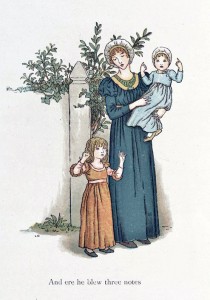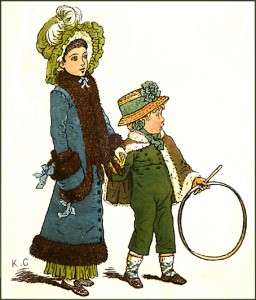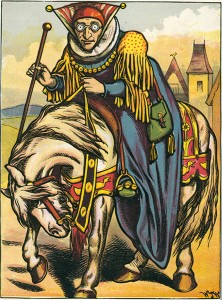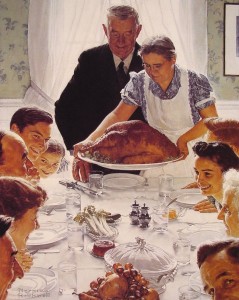
Another ABE e-mail came my way and I was surprised to see it was about the illustrator of children’s books, Kate Greenaway. Her work is everywhere-that’s what public domain can do for a long dead artist. I knew nothing about her life, the article at ABE sheds some light on it, and the fact that she died young–well, young to me–55–now that I’m older than that. Her books were happy happy happy. From ABE: “Settings and story-lines were generally idyllic and pleasant, with a focus on nature – happy children were depicted with flowers, birds, animals, and other natural elements.” If you aren’t familiar with her name, I bet you recognize the outfits on the ladies and children. Despite the fact that she didn’t live during the Regency Era, her illustrations were of bonnets and long straight dresses, her own style and design reminiscent of days gone by–or days that never were because the

feeling I get from viewing her pictures is fantasy. Not fantasy as in fairies and storybook tales, more along the lines of turning reality into her own perfect cute world. Is it obvious by now that I’m not a fan?
I’ve never liked Greenaway’s work. It lacks vibrancy, the people within her pictures aren’t lively, they’re staid. Even when in motion, the figures are lifeless. Every child and adult look the same. The same features, clothing, shoes, hair, bonnets, the similarities drive me to distraction. Her settings tend to be formal in tone. Topiary is abundant. Upper class houses are seen. On a site preserving books for generations to come they have a copy of her illustrations for Robert Browning’s Pied Piper of Hamelin poem. Boring! Dull. Tedious. However the characters are very well dressed. The town may have had rats, but no one was hurting for money, it seems. What is really shocking–the fashion world took note of Greenaway’s fahsion illustrations and decided to create clothing similar to her art work. Yikes! This in the middle of the Victorian era full of bustles and hoop skirts. In my mind’s eye I’m picturing a busy London street filled with ladies wearing her bonnets, carrying baskets with fingerless net gloves, flat shoes sinking into the muddy banks, the tips of straight skirts soiled as they skittle throughout the day.
And those kids! Cherubic and happy little souls, playing ring around the roses–without the ashes, ashes they all fall down, I’d guess. We don’t want to introduce the origin for the rhyme, all that tragedy from the Bubonic Plague must remain undisclosed in Greenaway’s lovely world. Granted, I’m very opinionated about children’s illustrators. However there are very few golden age artists that I don’t love in some way. Greenaway is the exception. I don’t know if the work I’ve been exposed to is all inclusive of her style–if so, then I’m right about the boring part. Many contemporaries of hers appeal to me much more–even a few who are nameless. Their work is either unsigned, or signed with no one knowing who it was. A particular

Victorian Mother Goose illustrator has struck me as being way before their time–the illustrations are witty and unusual. I far prefer some meat to the art work, than prettiness.
I’d no idea she illustrated so many books in her career. All of which run together in my eye. I suppose to Greenaway fans what I’m writing smacks of blasphemy. The general

populace does hold her work in high esteem. I look at Greenaway as the Precious Moments of her times. You know those collectibles, right? I gag when I see how ‘cute’ they depict characters in porcelain. But, to each their own of taste and loves of things. I’ve someone in my family who adores Precious Moments, and I still think highly of her, lol. And enable her addiction at birthdays etc. Kate Greenaway’s artwork has been licensed or utilized throughout the years too–as fabric, figurines, various and sundry stuff.
I suppose it comes down to how one looks at the world. Rose colored glasses are not my style. The Norman Rockwell picturescape of the American experience annoys me, doesn’t give me the warm cuddly feeling so many others derive from his romanticized works. I guess it’s because I know behind the cute soda fountain can lurk a pedophile just waiting for the right kid to come in and order a banana split. The young girl staring in the mirror probably upchucked her last meal to remain thin. And the relatives at Thanksgiving are bickering and fighting all the way through the pumpkin pie. Kate Greenaway is an early version of Rockwell–the British version, but one that attracted Americans with rosy views too.
Give me the L. L. Brookes, W. H. Robinsons of the day, whose work was filled with offbeat humor and little idealization. Kate Greenaway can remain the typical Hallmark card of illustrators to the masses.


A classmate in art school did a Ralph Steadman/Kate Greenaway mashup that managed to improve both artists. It was a bit like watching a silverback mountain gorilla on meth make sweet, sweet love to Martha Stewart, only will less poetry involved. I share your sentiments regarding Ms. Greenaway’s oeuvre and add revulsion tinged with a drop or two of consternation.
However, I do feel the need to defend Norman Rockwell. The more saccharine of his pieces are indeed hard to take. Like some of the still lifes from previous centuries, there is often a subtle hint of subversion in his work. His rosy-cheeked figures are, more often than not, raising an eyebrow if not a finger to people who see them as comforting affirmations of the existence lifeway that never really happened.
I don’t see that in Rockwell, although I will take another look. Your gorilla Martha Stewart idea is hilarious. Ralph Steadman, didn’t he do Alice? Or am I thinking of someone else?
Thanks! I credit sleep deprivation and yerba mate.
For some reason replies with links aren’t getting through. Steadman did create his own version of Alice. The best way I can think of to describe it is that Steadman border on Beardsley if AubreyBee had sat down at his drafting table the morning after a night of chasing the green faerie.
Yep–I think I have a first of his somewhere. I love Alice, and have lost track for some reason, of the different versions I own. Great description of his work on Alice!
I do feel the need to defend Norman Rockwell. The more saccharine of his pieces are indeed hard to take. Like some of the still lifes from previous centuries, there is often a subtle hint of subversion in his work. His rosy-cheeked figures are, more often than not, raising an eyebrow if not a finger to people who see them as comforting affirmations of the existence lifeway that never really happened.
That’s brilliant, window cleaning. I bow to your insight. By any chance, do you dress like Dr. Who and reside in Nashville?
What on earth?? Why do these spam comments keep showing up? I seem to be deleting them constantly. Was there a comment? There isn’t one now.
Desperate net weirdness. Some chooch reposted my reply and attached his or her commercial url.
These was very nice and interesting discussion going on here. The post is very nice. Read the whole content and was really very interesting.